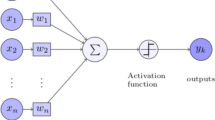Abstract
AR* models contain Autoregressive Moving Average and Generalized Autoregressive Conditional Heteroscedastic class model which are widely used in time series. Recent researches in forecasting with Generalized Regression Neural Network (GRNN) suggest that GRNN can be a promising alternative to the linear and nonlinear time series models. In this paper, a model composed of AR* and GRNN is proposed to take advantage of their feathers in linear and nonlinear modeling. In the AR*-GRNN model, AR* modeling improves the forecasting performance of the combined model by capturing statistical and volatility information from the time series. The relative experiments testify that the combined model provides an effective way to improve forecasting performance which can be achieved by either of the models used separately.





Similar content being viewed by others
References
Nelson D (1991) Conditional heteroscedasticity in asset returns: a new approach. Econometrica 59:347–370
Nelson DB (1990) ARCH models as diffusion approximations. J Econom 45:7–38
Andersen TG, Bollerslev T (1998) Answering the skeptics: yes, standard volatility models do provide accurate forecasts. Int Econ Rev 39:885–905
Bollerslev T, Chou RY, Kroner KF (1992) ARCH modeling in finance: a review of the theory and empirical evidence. J Econom 52:5–59
Gourieroux C (1997) ARCH models and financial applications. Springer, Heidelberg
Cao LJ, Tay Francis EH (2001) Financial forecasting using support vector machines. Neural Comput Appl 10:184–192
Qai M, Zhang GP (2001) An investigation of model selection criteria for neural network time series forecasting. Eur J Oper Res 132:188–102
McNelis PD (2005) Neural networks in finance: gaining predictive edge in the market. Elsevier/Academic, Amsterdam/London
Zhang P-Y, Lu T-S, Song L-B (2005) RBF networks-based inverse kinematics of 6R manipulator. Int J Adv Manuf Technol 26:144–147
Leung MT, Chen AS, Daouk H (2000) Forecasting exchange rates using general regression neural networks. Comput Oper Res 27:1093–1110
Tang Z, Almeida C, P.A. (1991) Fishwick, Time series forecasting using neural networks vs Box–Jenkins methodology. Simulation 57:303–310
Palit AK, Popovic D (2001) Nonlinear combination of forecasts using artificial neural network, fuzzy logic and neurofuzzy approaches. In: Proceedings of the 9th IEEE international conference on fuzzy systems. Melbourne, Australia
Peter Zhang G (2004) Time series forecasting using a hybrid ARIMA and neural network model. Neurocomputing 50:159–175
Li W, Liu J, Le J, Wang X-R (2005) The financial time series forecasting based on proposed ARMA-GRNN model. In: Proc. of 2005 intl. conf. on machine learning and cyberntics 2005–2009
Li W, Liu J, Le J (2005) Using GARCH–GRNN model to forecast financial time series. In: Proc. of the 20th international symposium on computer and information sciences. Istanbul, Turkey, Springer, LNCS vol 3733, pp 565–574
Box GEP, Jenkins GM, Reinsel GC (1994) Time series analysis: forecasting and control, 3rd edn. Prentice–Hall, Englewood Cliffs
Bollerslev T (1986) Generalized autoregressive conditional heteroskedasticity. J Econom 31:307–327
Engle RF (1982) Autoregressive conditional heteroskedasticity with estimates of the variance of UK inflation. Econometrica 50:987–1008
Specht DF (1991) A general regression neural network. IEEE Trans Neural Netw 2:568–576
Pai P-F, Lin C-S (2005) Using support vector machines to forecast the production values of the machinery industry in Taiwan. Int J Adv Manuf Technol
Wasserman PD (1993) Advanced methods in neural computing. Van Nostrand Reinhold, New York, pp 155–161
http://www.mathworks.com/access/helpdesk/help/toolbox/nnet/radial79. html
Efron B (1983) Estimating the error rate of a prediction rule: improvement on cross validation. J Am Stat Assoc 78(382):316–331
LeBaron B (1998) An evolutionary bootstrap method for selecting dynamic trading strategies. In: Refenes APN, Burgess AN, Moody JD (eds) Decision technologies for computational finance. Kluwer, Amsterdam, pp 141–160
Author information
Authors and Affiliations
Corresponding author
Rights and permissions
About this article
Cite this article
Li, W., Luo, Y., Zhu, Q. et al. Applications of AR*-GRNN model for financial time series forecasting. Neural Comput & Applic 17, 441–448 (2008). https://doi.org/10.1007/s00521-007-0131-9
Received:
Accepted:
Published:
Issue Date:
DOI: https://doi.org/10.1007/s00521-007-0131-9




